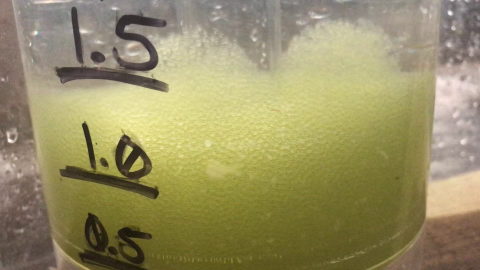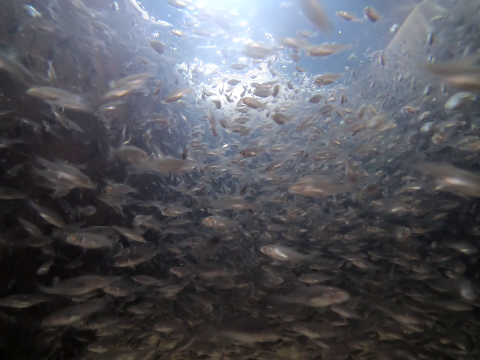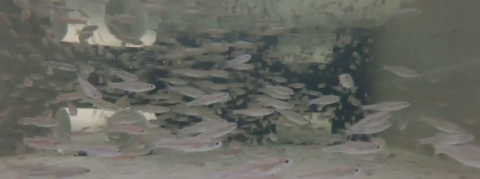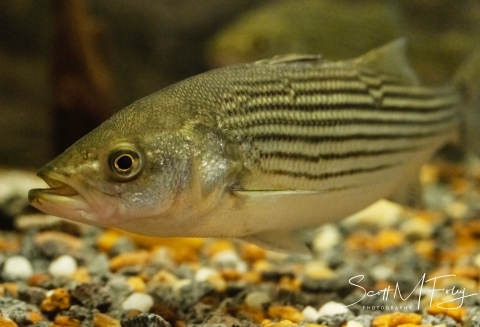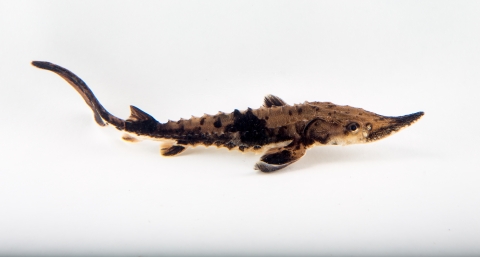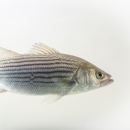Seasons of Wildlife
Striped bass:
Striped bass are in the public aquarium year round.
To see eggs and larval fish: mid- April-mid May
Best chance of seeing young striped bass in the holding house: June, November
They are difficult to see in the ponds!
Lake sturgeon:
You can see lake sturgeon in the public aquarium year round.
Typically in the holding house June-September
White shiners:
You can see white shiners in the public aquarium year round.
Johnny Darters:
These darters are in the brick holding house year round.
Cape Fear shiners:
These fish are at the hatchery in the spring and summer, but are difficult to see in their tanks.
Gopher frogs:
These are at the hatchery from May-July, but are difficult to see in their tanks.
Featured Species
Edenton NFH raises fish and other aquatic animals. Our two largest programs are Atlantic Striped Bass and Lake Sturgeon. We raise White Shiners and Cape Fear Shiners for conservation purposes. We have recently expanded to raising gopher frogs. These frogs are designated by the state of North Carolina as endangered.
Striped Bass
Striped bass live up to 30 years, grow up to 5 feet in length and weigh up to 77 ponds! Striped bass spend much of their lives in salt water, but return to a river to spawn. In the late 1800's, Albemarle Sound fisherman caught tens of thousands of striped bass per seine haul. A 2020 assessment by the state of North Carolina of the Central Southern Management Area (which includes the Tar and Neuse watersheds) concluded that striped bass populations are "depressed to the extent that the populations cannot sustain themselves with any level of fishing mortality...." Pollution, overfishing, and habitat loss have contributed to the decline of striped bass in NC.
Over the years, Edenton NFH in cooperation with the state of North Carolina has released hundreds of thousands of 4-6 inch striped bass and millions of striped bass fry in to the Tar and Neuse Rivers, NC. In 2019, the state of North Carolina put a moratorium in place on striped bass fishing in the Pamlico Sound as well as the Tar and Neuse Rivers. Since female striped bass are not able to reproduce until they are 4-8 years old, the goal is to allow more older females to return to the spawning grounds. In the coming years, NC biologists will determine if the populations are able to rebound by reducing the fishing pressure alone.
Lake Sturgeon
Lake sturgeon can live up to 150 years, grow more than 6 feet in length and weigh up to 200 pounds! In North Carolina, lake sturgeon are classified as a state species of concern. Due to changes in river/lakes, barriers (such as dams), overfishing, and pollution, lake sturgeon have been completely wiped out of North Carolina and other parts of the southeast for more than 50 years.
In 2014, Edenton NFH joined the Southeast Lake Sturgeon Working Group to help restore lake sturgeon to the Tennessee and Cumberland River systems. This working group is a multi-agency collaboration that spans many states and agencies. Edenton NFH has stocked over 20,000 lake sturgeon in the French Broad River, NC, and over 15,000 lake sturgeon in the Tennessee River, TN.
White Shiners
White shiners are native to parts of North Carolina, Virginia, and West Virginia. They reach a size of about 14 cm (5 inches). While white shiners are not threatened or endangered, they can play a valuable role in hatcheries that grow endangered mussels. Many mussel species such as the Tar spinymussel need a fish host so that young life stage of the mussel can feed. Without such a fish host, the young mussels would die. While mussel hatcheries could go out an collect white shiners from the wild, capturing them when needed can be unpredictable and stressful to the fish. When fish are stressed, they are more likely to show signs of disease.
In partnership with NC Wildlife Resources Commission and NC State University (NCSU), Edenton NFH produced their first successful batch of juvenile white shiners in 2019. These juvenile white shiners were distributed to the Marion Conservation Aquaculture Center, NCSU Aquatic Epidemiology and Conservation Laboratory, and Warm Springs National Fish Hatchery.
Cape Fear Shiners
Cape Fear shiners are native to the Deep Haw Rocky and upper Cape Fear Rivers in the Central Piedmont of North Carolina. They are not known to exist in the wild any place else in the world! They reach a length of approximately 5 cm (2 inches). They were listed as endangered by the USFWS in 1987.
Edenton NFH has joined with the NC Wildlife Resources Commission and the USFWS Eastern North Carolina Ecological Services to bring adult Cape Fear shiners into the hatchery for spawning, then return both the adults and their young to their rivers. Along with other agencies addressing the problems that let to the decline of the Cape Fear shiners, Edenton NFH hopes to be a part of creating self-sustaining populations so this fish can be de-listed under the Endangered Species Act.
Gopher Frogs
Gopher frogs are native to the coastal plains of the Carolinas, Alabama, Georgia, and throughout most of Florida. They are listed as endangered by the state of North Carolina and is being considered for listing under the Endangered Species Act. They can reach sizes up to approximately 10 cm (~4 inches) in length and up to 150 grams (~5 oz).
In 2020, Edenton NFH partnered with the NC Wildlife Resources Commission, the US Forest Service, and the NC State's Center for Marines Sciences to help restore Gopher Frogs in the Croatan National Forest. While it is extremely difficult to get an accurate count of these secretive frogs, it is estimated that there to be 70 adult frogs left in Croatan National Forest. Together, we are "hopping" for the best!

